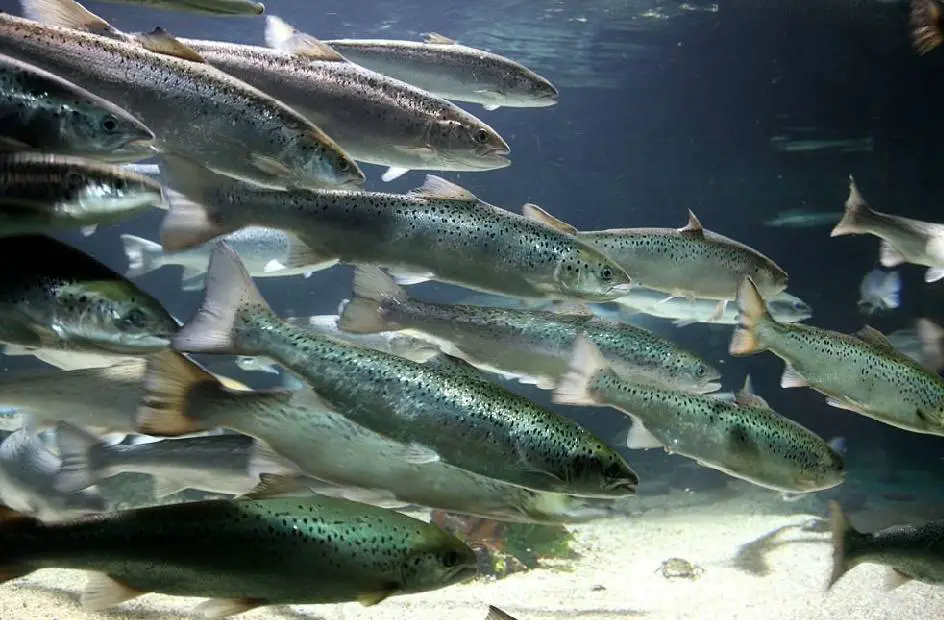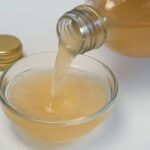Feeding your family with fish you’ve raised yourself can be a rewarding, sustainable way to put food on the table. However, not all species are equally suitable for backyard farming or delicious as dinner! This article will guide you through the best fish to raise for food – from popular choices like carp and catfish to potential surprises like koi.
Ready? Let’s dive in!
Key Takeaways
- Cod is a profitable and versatile fish to raise for food, known for its mild flavor and high demand worldwide.
- Catfish is the most popular choice for backyard fish farming in the US, thanks to its resilience, adaptability, and market demand.
- Tilapia is an ideal fish species for aquaponics systems and warm water conditions, offering fast growth rate and adaptability.

The Most Profitable Fish to Raise
When it comes to raising fish for food, there are several profitable options such as Cod, Catfish, Eel, Carp, Goldfish, Prawns, Tilapia, Tuna, Salmon, Perch Trout Barramundi and Koi.
Cod
Cod farming has grown in popularity due to its high demand across the globe. Known for its mild, slightly sweet flavor and flaky white flesh, cod is a versatile choice for numerous dishes.
Its natural habitat ranges from cold arctic waters which indicates it thrives best in colder climates. Providing the right environment ensures healthier growth of Cod fish and results in higher quality meat that’s packed with protein and essential nutrients like Omega-3 fatty acids.
It’s important to note that sustainable practices are crucial when raising this species due to concerns about overfishing and depletion of wild cod stocks.
Catfish
Catfish is the most popular fish species for farming in the United States. It is also one of the easiest fish to raise, making it an ideal choice for beginners in aquaponics. Catfish can thrive in areas with unreliable electrical supply, making it a resilient option for farming in various conditions.
Additionally, catfish is widely consumed and highly sought after, which means there is a significant market demand for this fish species. Whether you are considering raising catfish for personal consumption or as a business venture, this versatile and profitable fish could be the perfect choice.
Eel
Eel is a unique fish species that can be a great choice for raising in aquaculture or backyard farms. With their slender bodies and smooth skin, eels are known for their versatility in different culinary dishes.
They have a high market demand due to their rich flavor and texture. Eels are also highly adaptable to various environments, making them suitable for both freshwater and saltwater farming systems.
As an added benefit, eels grow quickly and require minimal maintenance, making them an excellent option for those looking to raise fish for food production purposes.
Prawns
Prawns are a popular choice for raising in aquaponics systems and backyard fish farming. These crustaceans are known for their delicious taste and high market demand. Prawns can thrive in freshwater or brackish water environments, making them versatile for different setups.
They require minimal maintenance and can be easily raised alongside other fish species. In addition to being a great source of food, prawns also provide an opportunity for profitable ventures due to their high market value.
With the right conditions and proper care, prawn farming can be a rewarding endeavor for both individuals and commercial operations alike.
Tilapia
Tilapia is a commonly farmed fish species in the US, especially in warm water conditions. It is ideal for backyard fish farming and aquaponics systems due to its resilience and adaptability.
Tilapia can tolerate a wide range of environments and feed on both plants and insects, making them easy to maintain. They also have a rapid growth rate, which means they can be harvested sooner than other fish species.
Additionally, tilapia has become popular for its mild flavor and versatility in cooking, making it a great choice for those looking to raise their own food at home.
Tuna
Tuna is a popular fish species that is commonly raised for food. It is highly sought after for its rich flavor and versatile uses in various cuisines. Tuna can be farmed in captivity or caught from the wild, with different species such as yellowfin, bluefin, and skipjack being the most common types consumed.
Tuna is known for its high protein content and omega-3 fatty acids, making it a nutritious choice for those looking to incorporate healthy seafood into their diet. Whether enjoyed raw in sushi or cooked on the grill, tuna provides a delicious and healthy option for food lovers everywhere.
Salmon
Salmon is a highly popular fish for both eating and farming. It is known for its rich flavor and high nutritional value. Salmon is packed with omega-3 fatty acids, which are important for heart health.
It also provides protein, vitamins, and minerals. Alaskan salmon is particularly prized for its quality and taste. Whether you enjoy it grilled, baked, or smoked, salmon is a delicious choice for adding variety to your meals while reaping the health benefits that this fish offers.
Perch
Perch is another highly popular fish species for farming and consumption. It is known for its delicious flavor and firm texture, making it a favorite choice among seafood lovers. Perch can be raised in both freshwater and saltwater environments, which makes it versatile for different aquaculture setups.
In addition to being a tasty food fish, perch is also sought after by anglers for sport fishing. Its abundance in lakes and rivers makes it an accessible option for backyard fish farming or commercial operations.
With proper care and management, raising perch can be a profitable venture due to its strong demand in the market.
Perch’s adaptability to various habitats allows farmers to raise them alongside other compatible species such as trout or catfish in aquaponics systems. This versatility adds flexibility to sustainable fish farming practices while ensuring efficient resource utilization.
Trout
Trout is another suitable fish species for farming in the US. It is known for its delicate flavor and high nutritional value, making it a popular choice among seafood lovers. Trout can be raised in both freshwater ponds and tanks, making it versatile for backyard fish farming.
It thrives well in cool water conditions and requires good water quality to ensure healthy growth. With proper care and attention to their needs, trout can be a profitable option for individuals looking to raise fish for food or even as a side business venture.
Barramundi
Barramundi is a versatile fish that is commonly raised for both food and aquaponics systems. It is a prized species due to its mild, buttery flavor and high nutritional value. Barramundi can be farmed in freshwater or saltwater environments, making it adaptable to different farming conditions.
This species grows quickly and has a high feed conversion rate, making it an efficient option for commercial fish farming. In addition, barramundi has good resistance to diseases and parasites, reducing the need for medications or chemicals.
Whether you’re looking to raise barramundi for food or as part of an aquaponics system, this fish offers great potential for sustainable seafood production.
Koi
Koi, also known as brocaded carp, is a resilient fish species that thrives in backyard fish farming. It is particularly popular for those looking to raise and sell the fish as pets.
Koi are known for their beautiful colors and patterns, making them sought after by pond enthusiasts. They are hardy and can survive in various water conditions, which makes them a great choice for beginners in aquaculture.
With proper care and attention, koi can provide an enjoyable and profitable venture in fish farming.
The Best Fish for Aquaponics
Tilapia, trout, catfish, goldfish, and koi are among the best fish for aquaponics. Read on to discover why they thrive in this system!
Tilapia

Tilapia is a popular fish species for farming, especially in warm water conditions. It is commonly farmed in the US and can provide a sustainable source of food. Tilapia is known for its fast growth rate and adaptability to different environments, making it an ideal choice for backyard fish farming.
With proper care and farming techniques, tilapia can be a profitable venture for those interested in aquaculture. Additionally, tilapia is also one of the recommended fish species for aquaponics systems due to its ability to tolerate fluctuating water temperatures and poor water quality.
Overall, tilapia is a versatile fish that can be raised successfully both in traditional farming setups as well as in aquaponics systems.
Trout
Trout is a popular fish species for farming in the United States. It is well-suited for aquaculture and can be easily raised in backyard ponds or tanks. Trout are known for their delicious taste and are rich in omega-3 fatty acids, making them a healthy choice.
They also have a fast growth rate, which means they can be harvested within a relatively short period of time. For those looking to start fish farming at home, trout is definitely worth considering as it offers both profitability and culinary enjoyment.
Catfish
Catfish is the most popular fish species for farming in the United States. It’s a hardy and adaptable fish that thrives in various environments, making it suitable for both backyard aquaponics systems and traditional fish farming operations.
Catfish is also relatively easy to raise, making it an excellent choice for beginners in aquaculture. In addition to its ease of farming, catfish is a nutritious and flavorful fish that can be enjoyed in a variety of dishes.
Whether you’re looking to start your own backyard farm or explore larger-scale aquaculture, catfish should definitely be on your list of options.
Prawn
Prawns are another excellent choice for fish farming, particularly in aquaponics systems. They are known for their fast growth rate and high yield, making them a profitable option for food production.
Prawns can adapt well to various water conditions and feed on a wide range of organic matter, including algae and small insects. Additionally, they have a delicious taste and are highly sought after by seafood lovers.
Overall, prawns are a versatile species that can thrive in both backyard aquaponics setups as well as larger-scale commercial operations.
Bass
Bass is a popular fish species for aquaponics because it can adapt well to different environments. This makes it suitable for both indoor and outdoor farming systems. Bass is known for its delicious flavor, making it a favorite choice for many people looking to raise fish for food.
Additionally, bass can be easily bred in captivity, which means that farmers can quickly build up their stock and increase their production. With proper care and attention, bass can thrive in an aquaponics system and provide a sustainable source of food for your family or business.
Barramundi
Barramundi is a popular fish species for both food and aquaponics systems. It has a mild flavor and firm texture, making it versatile in various recipes. Barramundi is known for its high protein content and omega-3 fatty acids, which are beneficial for heart health.
This fish can thrive in freshwater or brackish water conditions, making it suitable for different farming setups. Whether you’re looking to raise barramundi for personal consumption or as a sustainable business venture, this species offers great potential due to its taste, nutrition profile, and adaptability.
Perch
Perch is a popular fish species for both food production and aquaponics. It is known for its delicate flavor and firm, white flesh. Perch can be found in freshwater environments, making it ideal for backyard fish farming or sustainable aquaculture systems.
Additionally, perch is rich in omega-3 fatty acids, which promote heart health and reduce inflammation. Whether you’re looking to raise perch for personal consumption or as a profitable venture, this versatile fish species can be a great choice.
Salmon
Salmon is a highly sought-after fish for its delicious taste and nutritional benefits. It is rich in omega-3 fatty acids, which promote heart health and reduce inflammation. Salmon farming has become increasingly popular due to the high demand for this fish.
Alaskan salmon is known for its superior quality and flavor, making it one of the best types of fish to eat. Whether you are raising salmon in aquaponics systems or backyard ponds, proper care and feeding are essential to ensure their healthy growth.
Walleye
Walleye is a popular fish species for raising in aquaponics systems. It is known for its mild flavor and firm, white flesh, making it a favorite among seafood lovers. Walleye are also relatively easy to care for and can adapt well to different water conditions.
They are highly sought after by anglers, which makes them a profitable choice for aquaculture. In addition, walleye has high nutritional value, rich in omega-3 fatty acids and protein.
Whether you’re looking to grow fish for food or recreational purposes, walleye is definitely worth considering as one of the best options.
Bonus: choosing the best fish for pets
Goldfish
Goldfish are not only beautiful ornamental fish but can also be raised for food. Although they may not be the most popular choice, goldfish can provide a sustainable source of protein.
These resilient fish do well in backyard fish farming setups and are often raised to sell as pets. With their bright colors and distinctive patterns, goldfish add an aesthetic appeal to any aquaponics system or garden pond.
They are relatively easy to care for and can adapt well to different water conditions. Additionally, goldfish have been bred in various sizes, making them versatile for different purposes in fish farming.
Furthermore, goldfish offer a unique opportunity for those looking to enter the market of selling live ornamental fish. Due to their popularity as pets, there is always a demand for high-quality goldfish varieties such as koi or brocaded carp.
By focusing on breeding and raising these sought-after strains of goldfish, individuals can potentially tap into a niche market that values these unique and often valuable specimens.
Koi
Koi, also known as brocaded carp, is a resilient fish species that thrives in backyard fish farming. They are particularly popular for raising as pets. Koi are hardy and can adapt to different water conditions, making them an ideal choice for beginners.
These colorful beauties add aesthetic appeal to any backyard pond while providing a potential source of food or income. Koi are known for their vibrant scales and graceful movements, making them a favorite among fish enthusiasts.
Raising Fish for Survival Food
Learn how to raise fish in your backyard, farm ponds, or tanks with a filter system and ideal grow season. Discover the best breeds and tips for warmer climates. Find more information on sustainable fish farming techniques for fresh seafood production.
Backyard fish farming
Backyard fish farming is a sustainable way to provide a source of fresh fish for food. Similar to vegetable gardening, it allows individuals to have control over the quality and quantity of their food.
Carp, catfish, tilapia, trout, and koi are all popular choices for backyard fish farming. This practice can be profitable if the right species are chosen and proper techniques are used.
With a small system including tanks or ponds and a filter system, anyone can enjoy the benefits of backyard fish farming.
Farm ponds
Farm ponds are a great option for raising fish for food. They provide a controlled environment where fish can thrive and grow. With the right conditions, such as proper filtration systems and ideal water temperature, farm ponds can support various species of fish like tilapia, catfish, trout, and perch.
These freshwater ponds offer self-sustaining ecosystems that allow fish to reproduce naturally. Farm pond fishing can be a profitable venture when the right species are chosen and proper farming techniques are employed.
Tanks
Tanks are a popular option for raising fish for food, especially in areas where space is limited. They provide a controlled environment that allows for efficient and effective fish farming.
In tanks, you can closely monitor water quality, temperature, and feeding habits to ensure the health and growth of your fish. Tanks also make it easier to protect the fish from predators or diseases that could harm their well-being.
Additionally, tanks can be easily set up indoors or outdoors, making them suitable for backyard aquaculture or even urban farming initiatives. With proper maintenance and care, tanks offer a reliable way to raise fish for food at home or on a larger scale.
Filter system
A filter system is an essential component of fish farming, whether it’s done in a backyard or on a larger scale. It helps to maintain the water quality by removing waste and impurities, ensuring that the fish have a healthy environment to thrive in.
A well-designed filter system can improve the overall efficiency of the fish farming operation and reduce the risk of disease outbreaks. By properly filtering the water, farmers can ensure that their fish are getting enough oxygen and nutrients for optimal growth.
Different types of filters may be used depending on factors such as the size of the farm and the type of fish being raised. Regular maintenance and cleaning are also important to keep the filter system running smoothly and effectively.
In aquaponics systems, where fish farming is combined with hydroponic vegetable cultivation, the filter system plays a crucial role in recycling nutrients from fish waste into plant food.
This sustainable approach maximizes resource utilization while minimizing environmental impact. The filtering process removes solid waste particles from recirculating water before it flows to plants through grow beds or other hydroponic setups.
Overall, investing in a good-quality filter system is vital for successful fish farming operations, as it helps maintain water quality, optimize growth conditions for fishes, improve nutrient recycling in aquaponics systems,and contributes towards more sustainable practices in freshwater aquaculture industry.
Ideal grow season
Different fish species have specific requirements when it comes to the ideal grow season. For example, carp and catfish thrive in warmer water temperatures, making them well-suited for growth during the summer months.
Tilapia, on the other hand, can tolerate a wider range of temperatures and can be grown year-round in both warm and cold climates. Trout prefer cooler water temperatures and are best raised during spring or fall when water conditions are favorable.
Understanding the ideal grow season for each fish species is crucial for successful fish farming and maximizing their growth potential.
Aquarium heaters
Aquarium heaters are essential for maintaining a stable water temperature in fish tanks. They ensure that the water stays warm enough for the fish to thrive, especially in colder climates or during the winter months.
By providing a controlled environment, aquarium heaters help prevent stress and illness among the fish. It is important to choose a heater that is suitable for your tank size and adjust it according to the specific needs of your fish species.
Properly functioning aquarium heaters ensure the overall health and well-being of your aquatic pets.
Additional Tips for Raising Fish for Food

Choose the best breeds for your specific needs and consider warmer climate considerations to ensure successful fish farming.
Best breeds
When it comes to choosing the best fish breeds for raising them as a food source, there are several options to consider. Tilapia is a popular choice due to its fast growth rate and ability to adapt to different environments.
Trout is another excellent option, known for its delicious taste and high nutritional value. Catfish is also a common choice, especially in the United States where it is widely farmed.
Additionally, carp and salmon are both good choices for their versatility and popularity in many cuisines around the world. Whatever breed you choose, proper farming techniques and conditions will ensure successful fish farming for food production.
Raising fish at home can be a profitable venture if you choose the right breeds. Tilapia has gained popularity due to its fast growth rate and resilience in warm water conditions. Trout is another highly sought-after breed known for its flavorful meat and high nutritional content.
Catfish remains a favorite among beginners due to their hardiness and adaptability in aquaponics systems with unreliable power supply. Carp and salmon are versatile breeds that can flourish in various environments making them suitable choices as well.
Warmer climate considerations
Fish farming in warmer climates presents certain considerations that fish farmers need to keep in mind. Firstly, it is important to choose fish species that can tolerate high temperatures and thrive in warm water conditions.
Tilapia, for example, is a popular choice for warm water aquaculture due to its ability to adapt well to higher temperatures. Additionally, farmers should also consider the impact of warmer weather on water oxygen levels, as warmer water holds less dissolved oxygen than cooler water.
This can be mitigated by providing adequate aeration systems or using oxygenation techniques such as paddlewheel aerators or diffusers.
Another consideration is the increased risk of disease and parasites in warmer climates. Warmer waters can create an ideal environment for certain pathogens and parasites to thrive.
Fish farmers must take proactive measures such as regular monitoring, proper nutrition, and maintaining good water quality to minimize the risk of diseases spreading among their fish populations.
Lastly, with rising global temperatures and climate change impacts becoming more evident, it is crucial for fish farmers to stay informed about changing weather patterns and adapt their farming practices accordingly.
This may involve implementing strategies like shade structures or employing cooling methods during heatwaves.
Resources for more information
For more information on raising fish for food, there are several resources you can explore. Online forums and communities dedicated to aquaculture and fish farming can provide valuable insights and advice from experienced individuals.
Books on sustainable fish farming techniques can also be helpful in understanding the best practices for maximizing your yield. Additionally, local agricultural extension offices or universities may offer classes or workshops on aquaculture that can enhance your knowledge and skills.
Take advantage of these resources to further educate yourself and ensure success in raising fish for food.
Conclusion
When it comes to raising fish for food, there are several top choices that stand out. From the profitable options like cod and catfish to the versatile tilapia and trout, you have a variety of species to choose from.
Whether you’re considering backyard aquaponics or want to explore sustainable fish farming techniques, selecting the right fish species can make all the difference in your success.
So, take some time to research and determine which fish will best suit your needs and goals for food production. Happy fishing!
FAQs
1. What are the best fish to raise for food?
Some of the best fish to raise for food include tilapia, catfish, trout, and salmon.
2. How long does it take for these fish to reach maturity?
The time it takes for these fish to reach maturity varies depending on the species, but generally ranges from 6 months to 2 years.
3. Can I raise these fish in my backyard or small-scale setup?
Yes, many of these fish can be successfully raised in a backyard or small-scale setup using ponds, tanks, or aquaponics systems.
4. What are the advantages of raising your own fish for food?
Raising your own fish for food allows you to have a sustainable source of high-quality protein, control over their diet and growth conditions, and the satisfaction of knowing where your food comes from.

As a dedicated mother and passionate software developer, she weaves her diverse experiences into captivating stories that inspire and engage readers. Emma's love for sustainable living and environmental consciousness permeates both her personal and professional life. When she's not immersed in the world of coding and software development, Emma can be found nurturing her family and tending to her thriving organic garden. Her commitment to sustainable practices extends to every aspect of her life, from repurposing household items to embracing eco-friendly technologies.









